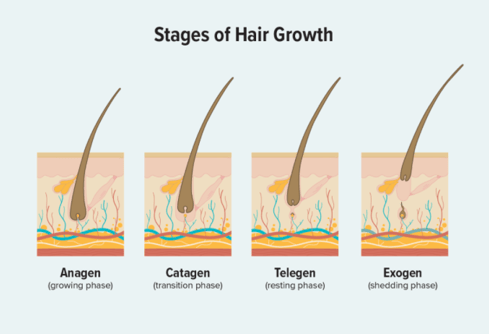"How Much Hair Loss is Normal? A Complete Guide to Understanding Shedding, Thinning, and When to Worry"
Wondering how much hair loss is normal? Learn about the hair growth cycle, what causes excessive shedding, and when to seek help. Plus, discover Truvairn, a trusted solution for healthier, stronger hair. Your guide to understanding and managing hair loss starts here!
Mimir Odin
2/23/20255 min read


Introduction
We’ve all been there standing in front of the mirror, staring at the hairbrush or shower drain, wondering, “Is this normal?” Hair loss can be a source of anxiety for many, but the truth is, shedding a few strands every day is completely natural. The real question is: How much hair loss is normal, and when should you start worrying?
In this blog, we’ll break down everything you need to know about hair loss, from the science behind your hair growth cycle to the factors that can trigger excessive shedding. We’ll also debunk common myths, share practical tips to keep your hair healthy, and introduce you to Truvairn, a trusted solution for those looking to take control of their hair health. Let’s dive in!
Understanding the Hair Growth Cycle
Your hair doesn’t grow continuously—it goes through a natural cycle with three main phases:
1. Anagen (Growth Phase): This is when your hair actively grows, lasting anywhere from 2 to 7 years. About 85-90% of your hair is in this phase at any given time.
2. Catagen (Transition Phase): A short phase (2-3 weeks) where hair stops growing and detaches from the blood supply.
3. Telogen (Resting Phase): Hair rests for about 3 months before shedding to make room for new growth.
On average, 50-100 hairs fall out daily as part of this cycle. So, if you notice a few strands on your pillow or in the shower, don’t panic—it’s just your body making way for new hair.
What Counts as Normal Hair Shedding?
Losing 50-100 hairs a day is completely normal. However, this number can vary depending on factors like:
- Hair thickness: People with thicker hair may shed more strands without it being noticeable.
- Hair length: Longer hair can look like more when it sheds, even if it’s within the normal range.
- Washing frequency: If you wash your hair less often, you might notice more shedding when you do, as loose hairs accumulate.
If you’re shedding more than 100 hairs a day or noticing thinning patches, it might be time to investigate further.
Factors That Can Increase Hair Shedding
Sometimes, hair shedding increases temporarily due to:
- Seasonal Changes: Many people experience more shedding in fall and spring.
- Stress: Physical or emotional stress can push more hairs into the telogen phase.
- Diet: Nutrient deficiencies (like iron, zinc, or biotin) can affect hair health.
- Postpartum Hormones: After childbirth, hormonal shifts can cause temporary hair loss.
- Medications: Certain drugs, like blood thinners or antidepressants, may lead to shedding.
These factors are usually temporary, and your hair should return to its normal growth cycle once the underlying cause is addressed.
When Hair Loss Becomes a Concern
While some shedding is normal, certain signs may indicate a deeper issue:
- Excessive Shedding: Losing clumps of hair or noticing significantly more strands than usual.
- Thinning Patches: Visible bald spots or a widening part.
- Receding Hairline: Common in men, but women can experience it too.
- Scalp Issues: Redness, itching, or flakiness alongside hair loss.
If you’re experiencing any of these symptoms, it’s time to consult a dermatologist or healthcare professional.
Male vs. Female Hair Loss Patterns
Hair loss can look different depending on your gender:
- Men: Often experience a receding hairline or bald spots (male pattern baldness).
- Women: Typically notice thinning at the crown or a widening part (female pattern hair loss).
Both types can be influenced by genetics, hormones, and lifestyle factors.
Medical Conditions and Deficiencies Linked to Hair Loss
Certain health issues can trigger unusual hair loss, including:
- Thyroid Disorders: Both hyperthyroidism and hypothyroidism can affect hair growth.
- Alopecia Areata: An autoimmune condition causing patchy hair loss.
- Iron Deficiency: Low iron levels can lead to thinning hair.
- Polycystic Ovary Syndrome (PCOS): Hormonal imbalances in women can cause hair loss.
If you suspect an underlying condition, a blood test or scalp biopsy can help identify the cause.
Myths vs. Facts About Hair Loss
Let’s clear up some common misconceptions:
- Myth: Washing your hair too often causes hair loss.
Fact: Washing removes already shed hairs—it doesn’t cause more to fall out.
- Myth: Wearing hats makes you bald.
Fact: Unless your hat is extremely tight, it won’t affect hair growth.
- Myth: Only men experience hair loss.
Fact: Women make up 40% of hair loss sufferers.
When to See a Doctor?
If you’re concerned about your hair loss, don’t hesitate to seek professional help. A dermatologist may recommend:
- Blood Tests: To check for deficiencies or hormonal imbalances.
- Scalp Biopsy: To examine hair follicles under a microscope.
- Trichoscopy: A non-invasive tool to analyze the scalp and hair.
Preventive Measures and Treatments
Here are some ways to keep your hair healthy and reduce shedding:
- Eat a Balanced Diet: Focus on protein, iron, zinc, and vitamins like biotin and D.
- Reduce Stress: Practice yoga, meditation, or deep breathing exercises.
- Use Gentle Hair Care Products: Avoid harsh chemicals and heat styling tools.
- Try Topical Treatments: Minoxidil (Rogaine) is a popular over-the-counter option.
- Consider Supplements: Biotin, collagen, and omega-3s can support hair health.
Introducing TruVairn: Your Solution for Healthier Hair
If you’re looking for a trusted, science-backed solution to hair loss, TruVairn is here to help. Designed with natural ingredients and advanced technology, Truvairn works to:
- Block DHT: A hormone linked to hair loss.
- Nourish Hair Follicles: Promoting stronger, healthier strands.
- Strengthen Weak Hair: Reducing breakage and improving thickness.
Why Choose TruVairn?
- Clinically Proven: Backed by studies and real-world results.
- Easy to Use: Simply apply as directed and watch your hair transform.
- Natural Ingredients: Free from harsh chemicals and safe for daily use.
Ready to take control of your hair health? Try TruVairn !today and experience the difference!
👉 [Click here to learn more and get started with Truvairn!]
FAQ Section
Q: How much hair loss is normal per day?
A: Losing 50-100 hairs daily is normal.
Q: Can stress cause hair loss?
A: Yes, stress can push more hairs into the shedding phase.
Q: Is hair loss reversible?
A: In many cases, yes—especially if caught early and treated properly.
Q: How does TruVairn work?
A: Truvairn blocks DHT, nourishes follicles, and strengthens weak strands for healthier hair growth.
Wellness
Your destination for Wellness, heath & Fitness, Your journey start here
Trust
contact@eleganbeautybrand@gmail.com
© 2024. All rights reserved.








